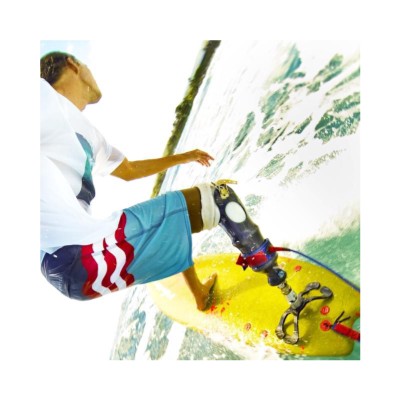

Mike Coots is adaptable. When the waves were no good for boogie boarding, he learned to surf. And when the rudimentary prosthetic leg he had–a stand-in for the biological one taken by a shark–wasn’t working so well for surfing, he adapted that, too.
Nevermind that he was told not to take it into the water in the first place. Nevermind that no one had made a prosthetic surf leg before. Among the necessary adaptations, which he tackled with a prosthetist in Hawaii, was its extreme ankle stiffness. When wearing it, he couldn’t squat down under a wave without being forced onto his tiptoes. But when made too flexible, the ankle absorbed all the energy necessary to turn his board.
Eventually he found a sweet spot, one he has surfed on for years. Not bad, judging from his stunning Instagram photos. But over in Iceland, a surfer who’d been following Coots on social media had additional ideas.
Dana Marlin had seen Coots’ photos, and as an employee of prosthetics company Össur’s intellectual property department, he was curious about what Coots was surfing on.
“He was just buying his prosthetics himself from eBay and kind of putting them together,” said Marlin. “I started to think about the problem to solve for the surf foot.” It was hardly intellectual property, but since he had access to the lab and the knowledge, he thought it might make for an interesting side project. Marlin messaged Coots: Was he interested in testing and working with them on a specially made surf foot?

Months later, the prototypes arrived on Coots’ doorstep. “Whoah,” thought Coots as he unpacked several feet, each resembling the steering wheel of a Formula One car.
For the most successful of the Formula-One feet, the Össur team did away with the biological foot’s asymmetry–advantageous for walking, but compensated for in stance when surfing. For the ankle, it mimicked the windsurfing “tendon,” a rubber piece that attaches the mast to the board, but still allows flexibility.
Össur also sent Coots the XC-VariFlex, a multi-purpose L-shaped foot for active individuals, and a “Cheetah Foot” made for running, both of which might lend ideas to the next surf-foot prototype. While Coots and Össur have already made a few alterations to the surf foot, the testing and collaboration have really just begun. “We’re getting really close,” Coots said, but only a winter in big Hawaiian swells will give them the data they need.
In the end, the foot may never see markets–it was never intended to–but as Marlin pointed out, “We are learning a lot from these feet.” The stability and heel-toe control they’ve achieved with the prototype could lend knowledge to all board-sports prosthetics and the balance could be useful on boats.
For Coots, better prosthetics mean bigger aspirations for amputees. “I think a lot of amputees get a bit discouraged,” he said. “I think if you can get amputees doing action sports and things that they love, it might even inspire others who aren’t even active.”



This post is part of How We Get To Next’s Vital Signs month, looking at the future of our global health throughout June 2016. If you liked this story, please click on the heart below to recommend it to your friends.
